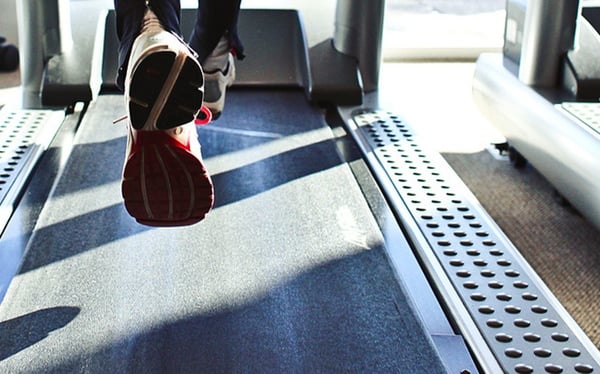Does the treadmill deserve a bad rap? Photograph courtesy of Flickr user eccampbell.
Ask most running coaches about treadmill training and they’ll scoff, offended that you even uttered the word in their presence. Sure, a treadmill doesn’t offer everything that an outdoor run can, and the lack of changing scenery may prevent that wonderful runner’s high afterward. But as one of the most popular pieces of cardio equipment, it must being doing something right. So why do so many people think it’s bad for our bodies?
“The treadmill is not bad for your body,” says local physical therapist Dr. Jamey Schrier. “The body is bad for the treadmill.”
As it turns out, the treadmill isn’t always the culprit of our injuries, whether it’s shin splints or knee pain. Schrier says often users already have a presdisposition to an injury that they aren’t aware of, which is only exacerbated by overuse of the treadmill. When running on a treadmill for 30 minutes at the same speed is our only workout every day, we’re likely to be more attuned to what’s going on with our body and more aware of injuries.
“Let’s say you have flat feet and you run again and again on the treadmill. That’s going to lead to problems in your foot, ankle, and hip from overuse,” Schrier says.
Fortunately, these issues can be easily fixed. First, consider the last time you changed your running shoes. Many runners get a new pair after approximately 300 miles of use.
If you’re concerned about injuries, a physical therapist can help determine whether your gait is the issue. Schrier says after videotaping patients run on a treadmill, it’s easy to pinpoint the problem and see whether you’re running incorrectly.
One of the most common mistakes Schrier sees patients making is failing to have a plan or purpose when they get on the machine. “Know the reason why you’re using it. Create a plan,” he says. “It will increase effectiveness and maximize what you’re trying to achieve.”
He recommends using the treadmill for three things: to lose weight, to improve your cardiovascular system, or for sports-specific training. For example, a football player might plan a treadmill workout that involves lots of hills and inclines to improve his leg strength. Intervals are a good tactic for a cardio workout, while running at a zero to low incline and at a moderate speed for 30 to 45 minutes is ideal for weight loss, Schrier says.
Users should also understand that a treadmill run is quite different from running outside. When on a treadmill, the surface moves under our feet. Outside, our feet move over the pavement or ground. “This different causes the body to work differently,” Schrier says. At the very least, runners should run at a 1 percent incline on a treadmill to mimic outdoor wind resistance.
Finally, Schrier says to remember that the “treadmill is a great tool, but it’s just one tool.” Our bodies like variety, he says, so don’t let the treadmill be the only form of exercise that you do.
“It’s not always the treadmill’s fault,” he reminds us. “We have to look at ourselves, too.”


















